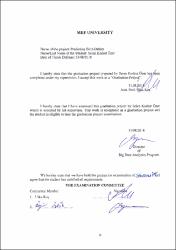Please use this identifier to cite or link to this item:
https://hdl.handle.net/20.500.11779/1184Full metadata record
| DC Field | Value | Language |
|---|---|---|
| dc.contributor.advisor | Koç, Utku | - |
| dc.contributor.author | Korkut Özer, Selen | - |
| dc.date.accessioned | 2019-11-12T13:42:01Z | |
| dc.date.available | 2019-11-12T13:42:01Z | |
| dc.date.issued | 2018 | - |
| dc.identifier.citation | Korkut Özer, S. (2018). Predicting birth defects, MEF Üniversitesi Fen Bilimleri Enstitüsü, İstanbul, Türkiye | en_US |
| dc.identifier.uri | https://hdl.handle.net/20.500.11779/1184 | - |
| dc.description.abstract | Many couples are eager to have a healthy baby. For this reason, the pregnant woman is trying to take their baby through the steps of adjusting their lives during the pregnancy, such as healthy nutrition, organic life, avoiding cosmetics. Even though the woman can do it, health problems can be observed in the baby at the time of birth or after birth. The causes of these health problems may be factors such as genetic, the physiological characteristics of the mother, environmental. In this paper, we tried to answer the question whether the health problems that occur in babies after childbirth can be estimated before birth. This includes the birth records of the American Centers for Disease Control and Prevention (CDC). Approximately 3M data was analyzed and the prediction model worked on the baby dataset. Boosting, Random Forest, Neural Network, Logistic Regression and SVM models were used to estimate the babies who could have any disease at birth. Sick babies were estimated with an accuracy of 69.5%. | en_US |
| dc.description.abstract | Birçok çift, sağlıklı bir bebek sahibi olmak ister. Bu nedenle kadın, hamilelik sırasında sağlıklı beslenme, organik yaşam, kozmatikten kaçınma gibi aksiyonlarla yaşamını bebek için değiştirmeye çalışmaktadır. Bunları yapmasına rağmen, doğum sırasında veya doğum sonrasında bebekte sağlık sorunları yaşanabilmektedir. Bu sorunlar genetik, fizyolojik ya da çevresel faktörlerden kaynaklı olabilir. Bu çalışmada doğumdan hemen sonra bebeklerde oluşan sağlık sorunları doğumdan önce tahmin edilebilir mi sorusuna yanıt aradık. Bu kapsamda Amerika Amerika Hastalık Kontrol ve Önleme Merkezi (CDC) nin doğum kayıtları kullandık. Yaklaşık olarak 3M data analiz edilerek, bir tahmin modeli çalışılmıştır. Doğumda herhangi bir hastalığı olabilecek bebekleri tahmin etmek için Boosting, Random Forest, Neural Network, Logistic Regression ve SVM modelleri kullanıldı. % 69.5 doğruluk oranıyla hasta bebekler tahmin edildi. | en_US |
| dc.language.iso | en | en_US |
| dc.publisher | MEF Üniversitesi, Fen Bilimleri Enstitüsü | en_US |
| dc.rights | info:eu-repo/semantics/openAccess | en_US |
| dc.subject | Pregnancy | en_US |
| dc.subject | Birth | en_US |
| dc.subject | Prediction | en_US |
| dc.subject | Imbalanced Dataset | en_US |
| dc.subject | Hamilelik | en_US |
| dc.subject | Doğum | en_US |
| dc.subject | Tahminleme | en_US |
| dc.subject | Dengesiz Veri Seti | en_US |
| dc.title | Predicting Birth Defects | en_US |
| dc.type | Master's Degree Project | en_US |
| dc.identifier.wosquality | N/A | - |
| dc.identifier.scopusquality | N/A | - |
| dc.relation.publicationcategory | YL-Bitirme Projesi | en_US |
| dc.department | Büyük Veri Analitigi Yüksek Lisans Programı | en_US |
| dc.institutionauthor | Korkut Özer, Selen | - |
| item.grantfulltext | open | - |
| item.languageiso639-1 | en | - |
| item.openairetype | Master's Degree Project | - |
| item.cerifentitytype | Publications | - |
| item.fulltext | With Fulltext | - |
| item.openairecristype | http://purl.org/coar/resource_type/c_18cf | - |
| Appears in Collections: | FBE, Yüksek Lisans, Proje Koleksiyonu | |
Files in This Item:
| File | Description | Size | Format | |
|---|---|---|---|---|
| SelenKorkutÖzer.pdf | YL- PROJE DOSYASI | 3.07 MB | Adobe PDF |  View/Open |
CORE Recommender
Sorry the service is unavailable at the moment. Please try again later.
Items in GCRIS Repository are protected by copyright, with all rights reserved, unless otherwise indicated.